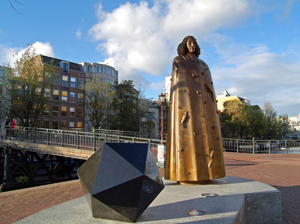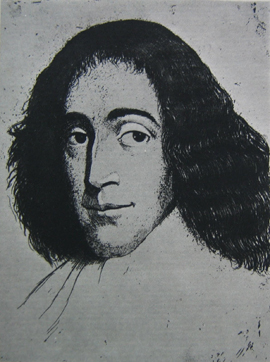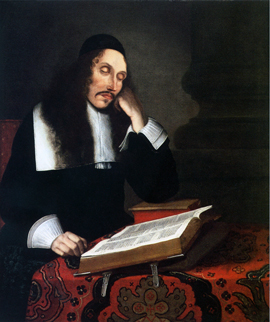| Profiles > Philosophy > Baruch Spinoza | |||||||||||||||
| Baruch Spinoza | |||||||||||||||
|
|||||||||||||||
|
|||||||||||||||
| Unorthodox Views | |||||||||||||||
| Spinoza’s intellectual reorientation came at a cost. His increasingly unorthodox views and laxity in his observance of the Jewish law strained his relations with the community. Tensions became so great that, in 1656, the elders of the synagogue undertook proceedings to excommunicate him. Without providing details, the formal written order (writ) of excommunication accuses him of abominable heresies and monstrous deeds. It then levels a series of curses against him and prohibits others from communicating with him, doing business with him, reading anything he might write, or even coming into close proximity with him. Spinoza may still have been a Jew, but he was now an outcast. | |||||||||||||||
 Little is known about Spinoza’s activities in the years immediately following his excommunication. He continued his studies with Van den Enden and occasionally took up residence in his teacher’s home. As it was now impossible for him to carry on in commerce, it was most likely at this time that he took up lens grinding as an occupation. There is also evidence that he traveled periodically to Leiden to study at the university. There he would have received formal instruction in Cartesian philosophy and become familiar with the work of prominent Dutch Cartesians. In 1661, he settled near Leiden, in the town of Rijnsburg.It was during this same period (in the late 1650s) that Spinoza embarked upon his literary career. His first work, the Treatise on the Emendation of the Intellect, is an attempt to formulate a philosophical method that would allow the mind to form the clear and distinct ideas that are necessary for its perfection. It contains, in addition, reflection upon the various kinds of knowledge, an extended treatment of definition, and a lengthy analysis of the nature and causes of doubt. For reasons that are unknown, the Treatise was left unfinished, though it appears that Spinoza always intended to complete it. Shortly thereafter, while in Rijnsburg, Spinoza set to work on his Short Treatise on God, Man, and His Well-Being. This work, circulated privately among friends, foreshadows many of the themes of his mature work, Ethics. Most notably, it contains an unambiguous statement of the most famous of Spinoza’s theses – the identity of God and Nature. Little is known about Spinoza’s activities in the years immediately following his excommunication. He continued his studies with Van den Enden and occasionally took up residence in his teacher’s home. As it was now impossible for him to carry on in commerce, it was most likely at this time that he took up lens grinding as an occupation. There is also evidence that he traveled periodically to Leiden to study at the university. There he would have received formal instruction in Cartesian philosophy and become familiar with the work of prominent Dutch Cartesians. In 1661, he settled near Leiden, in the town of Rijnsburg.It was during this same period (in the late 1650s) that Spinoza embarked upon his literary career. His first work, the Treatise on the Emendation of the Intellect, is an attempt to formulate a philosophical method that would allow the mind to form the clear and distinct ideas that are necessary for its perfection. It contains, in addition, reflection upon the various kinds of knowledge, an extended treatment of definition, and a lengthy analysis of the nature and causes of doubt. For reasons that are unknown, the Treatise was left unfinished, though it appears that Spinoza always intended to complete it. Shortly thereafter, while in Rijnsburg, Spinoza set to work on his Short Treatise on God, Man, and His Well-Being. This work, circulated privately among friends, foreshadows many of the themes of his mature work, Ethics. Most notably, it contains an unambiguous statement of the most famous of Spinoza’s theses – the identity of God and Nature.
|
|||||||||||||||
| Spinoza’s stay in Rijnsburg was brief. In 1663 he moved to the town of Voorburg, not far from The Hague, where he settled into a quiet, but busy, life. At the behest of friends, he immediately set about preparing for publication a set of lessons that he had given to a student in Leiden on Descartes’s Principles of Philosophy. The result was the only work that he was to publish under his own name, now Latinized to Benedict: René Descartes’s Principles of Philosophy, Parts I and II, Demonstrated According to the Geometric Method by Benedict de Spinoza of Amsterdam. As a condition of publication, Spinoza had his friend, Lodewijk Meyer, write a preface to the work, warning the reader that his aim was exposition only and that he did not endorse all of Descartes’s conclusions. He also appended a short piece, entitled Metaphysical Thoughts, in which he sketched some of his own views. Despite his admiration for Descartes, Spinoza did not want to be seen as a Cartesian. | |||||||||||||||
| Geometric Methods and Ethics | |||||||||||||||
| Upon opening Spinoza’s masterpiece -- Ethics -- one is immediately struck by its form. It is written in the style of a geometrical treatise, much like Euclid’s Elements, with each book comprising a set of definitions, axioms, propositions, scholia, and other features that make up the formal apparatus of geometry. One wonders why Spinoza would have employed this mode of presentation. The effort it required must have been enormous, and the result is a work that only the most dedicated of readers can make their way through. Some of this is explained by the fact that the seventeenth century was a time in which geometry was enjoying a resurgence of interest and was held in extraordinarily high esteem, especially within the intellectual circles in which Spinoza moved. We may add to this the fact that Spinoza, though not a Cartesian, was an avid student of Descartes’s works. As is well known, Descartes was the leading advocate of the use of geometric methods within philosophy, and his Meditations was written more geometrico, in the geometrical style. In this respect Ethics can be said to be Cartesian in inspiration. While this characterization is true, it needs qualification. Meditations and Ethics are very different works, not just in substance, but also in style. In order to understand this difference one must take into account the distinction between two types of geometrical methods -- the analytic and the synthetic. | |||||||||||||||
| Three Kinds of Knowledge | |||||||||||||||
 With this distinction between adequate and inadequate perception in place, Spinoza introduces a set of further distinctions. He begins with inadequate perception, which he now calls knowledge of the first kind, and divides it into two parts. The first consists of knowledge from random experience -- experientia vaga. This is knowledge from singular things which have been represented to us through the senses in a way which is mutilated, confused, and without order for the intellect. The second consists of knowledge from signs -- ex signis. For example, from the fact that, having heard or read certain words, we recollect things, and form certain ideas of them, like those through which we imagine the things. What links both of these forms of knowledge is that they lack a rational order. It is obvious that knowledge from random experience follows the order of the affections of the human body, but so does knowledge from signs. A Roman who hears the word pomum, for instance, will think of an apple, not because there is any rational connection between the word and the object, but only because they have been associated in his or her experience.When we reach what Spinoza calls the second kind of knowledge, reason (ratio), we have ascended from an inadequate to an adequate perception of things. This type of knowledge is gained from the fact that we have common notions and adequate ideas of the properties of things. What Spinoza has in mind here is what was just indicated -- namely, the formation of adequate ideas of the common properties of things and the movement by way of deductive inference to the formation of adequate ideas of other common properties. Unlike in the case of knowledge of the first kind, this order of ideas is rational.Spinoza does not pretend that any of this is easy. The acquisition of adequate ideas, especially those by which we attain knowledge of the third kind, is difficult, and we can never completely escape the influence of the passions. Nevertheless, Spinoza holds out to those who make the effort the promise, not of personal immortality, but of participation in eternity within this life. He closes the Ethics with these words: With this distinction between adequate and inadequate perception in place, Spinoza introduces a set of further distinctions. He begins with inadequate perception, which he now calls knowledge of the first kind, and divides it into two parts. The first consists of knowledge from random experience -- experientia vaga. This is knowledge from singular things which have been represented to us through the senses in a way which is mutilated, confused, and without order for the intellect. The second consists of knowledge from signs -- ex signis. For example, from the fact that, having heard or read certain words, we recollect things, and form certain ideas of them, like those through which we imagine the things. What links both of these forms of knowledge is that they lack a rational order. It is obvious that knowledge from random experience follows the order of the affections of the human body, but so does knowledge from signs. A Roman who hears the word pomum, for instance, will think of an apple, not because there is any rational connection between the word and the object, but only because they have been associated in his or her experience.When we reach what Spinoza calls the second kind of knowledge, reason (ratio), we have ascended from an inadequate to an adequate perception of things. This type of knowledge is gained from the fact that we have common notions and adequate ideas of the properties of things. What Spinoza has in mind here is what was just indicated -- namely, the formation of adequate ideas of the common properties of things and the movement by way of deductive inference to the formation of adequate ideas of other common properties. Unlike in the case of knowledge of the first kind, this order of ideas is rational.Spinoza does not pretend that any of this is easy. The acquisition of adequate ideas, especially those by which we attain knowledge of the third kind, is difficult, and we can never completely escape the influence of the passions. Nevertheless, Spinoza holds out to those who make the effort the promise, not of personal immortality, but of participation in eternity within this life. He closes the Ethics with these words:
|
|||||||||||||||
| If the way I have shown to lead to these things now seems very hard, still, it can be found. And of course, what is found so rarely must be hard. For if salvation were at hand, and could be found without great effort, how could nearly everyone neglect it? But all things excellent are as difficult as they are rare. | |||||||||||||||
|
Credits
en.wikipedia.org/wiki/Baruch_Spinoza www.iep.utm.edu/spinoza plato.stanford.edu/entries/spinoza |
|||||||||||||||
| 1Heterodox -- not conforming with accepted or orthodox standards or beliefs 2Marranos were originally Jews living in the Iberian Peninsula who converted or were forced to convert to Christianity, some of whom may have continued to practice Judaism in secret. The term came into later use in 1492 with the Castilian Alhambra Decree, reversing protections originally in the Treaty of Granada (1491). |
|||||||||||||||









